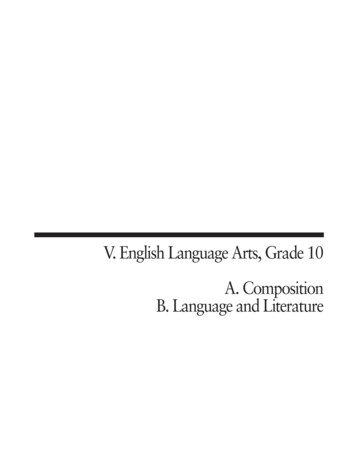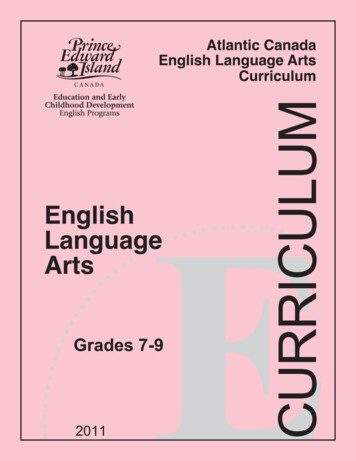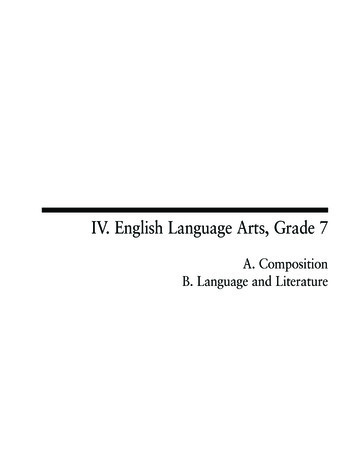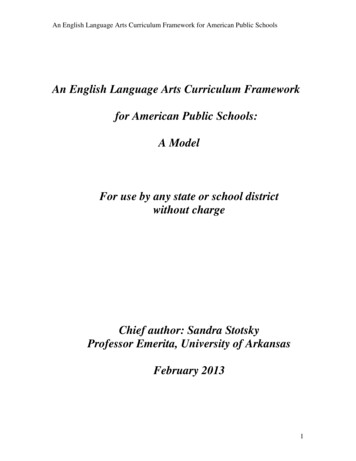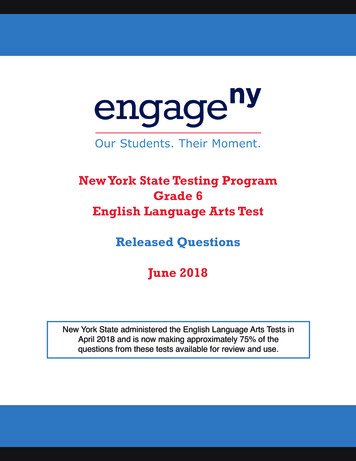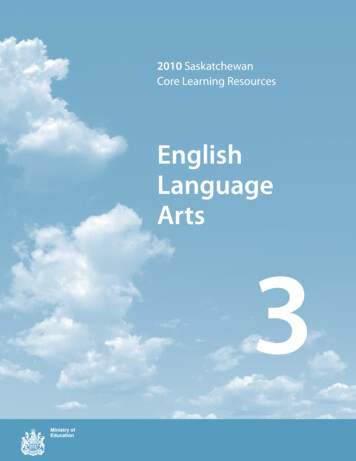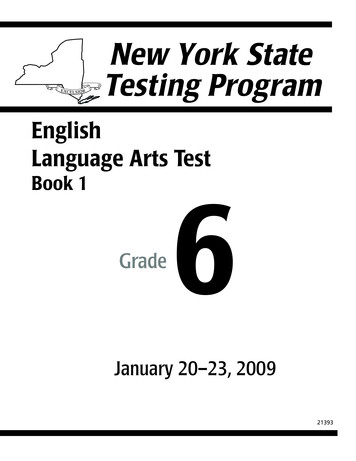
Transcription
EnglishLanguage Arts TestBook 1Grade6January 20–23, 200921393
TIPS FOR TAKING THE TESTHere are some suggestions to help you do your best: Be sure to read carefully all the directions in the test book. Plan your time. Read each question carefully and think about the answer before choosingyour response.Acknowledgments CTB/McGraw-Hill LLC is indebted to the following for permission to use material in this book:“The Wise Fools of Gotham” from Noodlehead Stories: World Tales Kids Can Read & Tell retold by Martha Hamilton and MitchWeiss. Copyright 2000 by Martha Hamilton and Mitch Weiss. Published by August House Publishers, Inc. and reprinted bypermission of Marian Reiner on their behalf.Abridgment and photographs from “A Boy Who Makes a Difference” by Diana Federman, text copyright 2007 by DianaFederman; photographs copyright Ryan’s Well Foundation. Used with permission.“The Wolf at My Window” by Diane Burns, from Ranger Rick Magazine’s April 1993 issue, text copyright 1993 by the NationalWildlife Federation, illustration copyright 1993 by Sal Catalano. Used by permission.“The Clever Crow” by Sara van Dyck, copyright 2004 CTB/McGraw-Hill LLC.Photograph of a Fish Crow holding a feather in its beak (Image No. IH165747), copyright by Lynda Richardson/Corbis.Used by permission.“Under the Rice Moon” by Rhiannon Puck, text reprinted by permission of Cricket Magazine, August 1996, Vol. 23, No. 12,text copyright 1996 by Rhiannon Puck, illustrations copyright 1996 by Kris Waldherr and reprinted by permission.Developed and published under contract with the New York State Education Department by CTB/McGraw-Hill LLC, a subsidiary of The McGraw-Hill Companies,Inc., 20 Ryan Ranch Road, Monterey, California 93940-5703. Copyright 2009 by the New York State Education Department. Permission is hereby granted for schooladministrators and educators to reproduce these materials, located online at http://www.emsc.nysed.gov/osa, in the quantities necessary for their school’s use, but not forsale, provided copyright notices are retained as they appear in these publications. This permission does not apply to distribution of these materials, electronically or by othermeans, other than for school use.
Book 1ReadingDirectionsIn this part of the test, you will do some reading and answer questions about whatyou have read.Go OnN SECURE MATERIAL NDo not reproduce. Do not discuss contentsuntil end of designated makeup schedule.Book 1Page1
DirectionsRead this story. Then answer questions 1 through 5.The Wise Fools ofGothamA Story from Englandby Martha Hamilton and Mitch WeissThere’s a small town in the central part ofEngland called Gotham. Some say it’s a town offools. Others say all the villagers are wise. Letme tell you about the people of Gotham so youcan decide for yourself.Long ago, England was ruled by a cruelking named John. One day, the people ofGotham heard that King John and his menwould soon be riding through their town. Thisworried the villagers, for they knew the greedyking would demand food and lodging for hismen. What’s more, if he saw anything to hisliking, he would surely take it.A town meeting was called. After muchdiscussion, the townspeople decided to cutdown a number of huge trees to block theroads leading into Gotham. When King Johnand his men reached the outskirts of thevillage, they could not pass. Enraged, KingJohn ordered his men to go into the town andpunish the villagers.When the king’s officers finally made theirway over the trees, they found a village offools. Some say that was because the people ofGotham had a plan—they had decided to actlike fools since they had never heard of anyonebeing punished for being a noodlehead. Otherssay that’s just the way they were.In the village, the king’s men encountereda man riding a donkey. The man was hunchedover because he carried a huge sack of grain onhis own shoulders. He looked exhausted. Oneof the king’s men approached him and asked,“Why, in heaven’s name, are you carrying thatsack? Why don’t you just put it behind you onyour donkey’s back?”Go OnN SECURE MATERIAL NDo not reproduce. Do not discuss contentsuntil end of designated makeup schedule.Book 1Page3
“You see,” replied the man from Gotham,“my donkey is feeling poorly today. It’s badenough that she has to carry me, so I decidedto lighten her burden by carrying the sackmyself.”The king’s officers couldn’t believe theirears. Drown an eel whose home is in the water?These men were sillier than the first man theymet!The king’s men said, “But sir, don’t you seethat if you’re riding on top of the donkey, she’sstill carrying the weight of the sack?”The man didn’t reply. He just looked at theking’s men as if they were crazy and went onhis way.The king’s officers giggled at the foolishnessof the man. Before long, they passed a pondwhere they found a number of villagers inthe midst of a great argument. Two of themwere holding an enormous eel. “Quiet down,”commanded one of the king’s men. “What’s theproblem here?”One of the villagers stepped forward andsaid, “Last year we took all the extra fish wecaught and put them in this pond so theywould multiply. But this year when we cameback, all we caught was this one huge eel.Obviously it has eaten all of our fish! Sincethen, we have argued long and hard over howto punish this wicked eel. But we have finallyagreed on the perfect punishment. We are justabout to drown the eel in this very pond!”1The king’s officers had heard enough.They couldn’t bring themselves to punish suchnincompoops. They returned to King Johnand told him all about the fools of Gotham.Whether it’s fair or not, the people of Gothamhave been known as fools ever since.What do you think? Were the villagers ofGotham wise or foolish?2This story is most likeABCDPageBefore long, they reached the center ofthe village, where they were in for anothersurprise. There they found the rest of thetownspeople building a towering stone wall.When the soldiers inquired what was goingon, one of the villagers replied, “Every springa cuckoo comes to live in our village. It alwaysbrings warm weather. When it leaves, the coldweather returns. Last year we decided that if wecould get the cuckoo to stay here all year, wewould always have warm weather. We built thisstone wall, but it obviously wasn’t high enoughbecause the bird flew away. This year we’redetermined to build it so high that the cuckoocan’t escape.”4What is the setting of this story?ABCDa folktalea news articlerealistic fictionhistorical fictionin a cityin a forestin a royal palacein a small villageN SECURE MATERIAL NBook 1Do not reproduce. Do not discuss contentsuntil end of designated makeup schedule.
3Why do the townspeople cut down the trees?ABCD4to build lodging for the king’s menThe townspeople are worried about the king’s visit because he willABCD5to make room for their cropsto block the roads to the villageto create a gift for the king’s menlaugh at themcut down their treestake anything he wantswant to move to their townBased on the story, why might the townspeople be considered wise?ABCDThey trick the king’s men into thinking they are fools.They think ahead by putting their extra fish into a pond.They make sure their donkeys are healthy enough to work.They realize the importance of warm weather to their crops.Go OnN SECURE MATERIAL NDo not reproduce. Do not discuss contentsuntil end of designated makeup schedule.Book 1Page5
DirectionsRead this article. Then answer questions 6 through 10.A Boy Who Makesa Differenceby Diana FedermanOne person can make a difference. Justask Ryan Hreljac (pronounced hurl-jack), whois 15 and lives in Canada. Without his help,hundreds of wells1 that now provide freshwater for people in Africa, Central America,and India might never have been built. Ryanis what you might call a water ambassador.He travels the world to tell people how theycan help solve a big problem: the lack of safedrinking water in many developing countries.“Everybody can do something,” Ryan says.Sometimes African-born Jimmy Akana—who is like a brother to Ryan—travels withhim to explain how water changed his life.The story of the two boys is the subject of anew children’s book, Ryan and Jimmy and theWell in Africa That Brought Them Together,written by Herb Shoveller and published byKids Can Press.Ryan’s efforts didn’t begin in a far-offplace, though, but right at home in Kemptville,Ontario. In 1998, when he was 6 years old,Ryan learned from his teacher that children inAfrica often must walk miles each day to findwater. Some even die from drinking bad water,his teacher said.1wells: storage areas built in the ground tohold waterPage6So Ryan decided to act. He did choresfor his parents, Susan and Mark, and forneighbors. He spoke to schools, churches,and clubs about his goal. The word spread,and donations began coming in. After severalmonths of hard work, Ryan had raised 2,000,enough to dig one well.An organization called Canadian Physiciansfor Aid and Relief (CPAR) chose a location forthe well in the village of Agweo, in Uganda (incentral eastern Africa). Ryan began writing to apen pal there—Jimmy—who was 9 and whoseparents had disappeared in a civil war.In 2000, CPAR arranged for Ryan to visitUganda for the opening ceremony of the well.Ryan and Jimmy met then and formed a closefriendship that took a dramatic turn in 2003.Jimmy’s life was in danger from the war, soRyan’s parents obtained permission for him tocome to Canada and join their family. That hasbeen his home ever since.N SECURE MATERIAL NBook 1Do not reproduce. Do not discuss contentsuntil end of designated makeup schedule.
about the vital importance of water. Now thefoundation has raised more than 1.5 millionand built 255 wells that serve more than427,000 people in 12 countries.Its website (www.ryanswell.ca) lists someof the famous people Ryan has met and theawards he has received, such as the Order ofOntario, the province’s highest honor.But Ryan isn’t bragging. “The mostimpressive people I’ve met are the other kidswho want to help, too,” he says. “The onlyreason I accept awards is that each word I saywhen I get one might help one more person.”Ryan helps out in UgandaAfter the first well, “the ripple effect tookover,” Ryan says, “and one goal led to another.”With adult help, he founded Ryan’s WellFoundation four years ago to educate people6***Asked if he ever feels discouraged thatmany people still lack good water, Ryan says,“It’s important to be an optimist. When peopleare dying on the other side of the world, to sitin your house and say, ‘I can’t really help,’ that’snot the person I want to be.“I’m just a typical kid. I had a smalldream, and I stayed with it. Everybody can dosomething.”7What problem is Ryan working tosolve?ABCDthe poor quality of schoolsa lack of safe drinking waterthe effect of war on childrena lack of proper medical careHow did Ryan first learn about theproblem he is trying to solve?ABCDfrom his teacherfrom his parentsfrom a children’s bookfrom a physicians’ organizationGo OnN SECURE MATERIAL NDo not reproduce. Do not discuss contentsuntil end of designated makeup schedule.Book 1Page7
8How did Ryan begin his project to build wells?ABCD9good deeds are often rewardedyoung people are good workersone boy’s actions help other peopleone boy’s life changes when he movesWhat would Ryan probably say is the most important part of making a dream come true?ABCDPageHe raised money by doing chores for people.The title of the article, “A Boy Who Makes a Difference,” suggests thatABCD10He created an educational foundation.He traveled to a village across the world.He started a website to request donations.8not giving upmaking friendsknowing your limitsnot bragging about awardsN SECURE MATERIAL NBook 1Do not reproduce. Do not discuss contentsuntil end of designated makeup schedule.
DirectionsRead this story. Then answer questions 11 through 14.The Wolfat MyWindowby Diane L. Burnsdrawing by Sal CatalanoWolf! Hank thought. The boy stared outthe cabin window at the lone creature. It wassitting a stone’s throw away in the moonlight.The wolf howled; Hank shivered. For thefirst time, he felt truly alone in these Idahomountains.It had felt so good to be allowed to comealong with Dad. Dad was a scientist whostudied wild animals. Together, Hank and Dadhad followed the tracks of mountain sheep,goats, and cougars. Through binoculars, they’dstudied coyotes and mule deer. And they’dcarefully recorded all the information in Dad’slogbook every night in their tent. Dad plannedto share the information with other wildlifescientists.Then, two days ago, they had moved intoan empty cabin. Here, Dad would write areport about what he had found. But theydiscovered that dozens and dozens of micehad taken over the cabin. The little rodentsscurried in and out through lots of tiny holesin the walls. . . . Worst of all, the mice hadgotten into the supplies of dried food andruined almost everything.Now, because most of the food was gone,Dad had left overnight to get new suppliesfrom town. Hank had insisted on staying behind.***The Wolf. Its howl sounded again. Hankopened the logbook to write about it, but hishand shook. Dad had never mentioned havingany trouble with wolves. But Hank’s friend Jillhad once told him of a shopkeeper in Montanawho’d faced a whole pack of wolves during ahard winter long ago. He’d been alone in hiscabin, Jill had said.Like I am now, Hank thought with anervous gulp. The wolves had chewed rightthrough a solid door, Jill had said, to geta smoked ham hanging from the ceiling.Go OnN SECURE MATERIAL NDo not reproduce. Do not discuss contentsuntil end of designated makeup schedule.Book 1Page9
But . . . Hank took a deep breath and forceddown his fright. How could such a story betrue? Dad had told him many times that wolveswere smart but shy, staying many miles awayfrom people. The big, bad wolf was just a fairytale, Hank thought. A 13-year-old boy was tooold for such things.Hank closed the logbook and put iton the table. Quickly he looked around forsomething he could use as a weapon—just incase. He grabbed a poker from the fireplace,went to the door, and took a deep breath.Then he opened the door, waved the poker,and yelled with all his might: “Go away, wolf!Go away!”Hank stared at the wolf. The wolf staredright back at him. Hank was staring into the eyesof a hunter. He knew, like all creatures, the wolfneeded to eat. Hank’s dad had said wolves playtheir part in the environment by eating deer, elk,rabbits, and other animals. But maybe, like thehungry mice that were frisking about Hank’sfeet, wolves go for any food they can find.10Now came a scratching sound—thesound of pawing at the cabin walls. And then,over the hammering of his heart, Hank heard ahigh-pitched, tiny . . . SQUEAK!Squeak? Holding his breath, Hank raisedhis head to see. The wolf was below thewindow, holding on to a small something.Then it lay in the grass and gulped down itsprize—a mouse!Startled, the wolf sprang up—and startedtrotting away. Hank closed the door and leanedback with a gasp. When he’d caught his breath,he turned back to the window. Oh, no! Therewas the wolf, sitting right where it had satbefore.PageSuddenly, the wolf sprang! Hank ducked,expecting to hear the window glass shatteringabove him. Instead, he heard a muffledsnuffling along the ground outside. The wolfwanted a way in! Hank shuddered. His heartpounded. If only Dad were here!The wolf stood up to pounce, stiff-legged,on another. Hank’s breath rushed out. Thewolf was hungry all right. But just for the kindof food it should eat, as Dad had said.***As the wolf pounced again, Hank openedthe logbook. He began to write, neatly andcarefully, every detail of his evening with thewolf. The story would be waiting for Dad whenhe returned in the morning—long after thesmart, shy wolf had moved on in search ofbigger animals to eat.N SECURE MATERIAL NBook 1Do not reproduce. Do not discuss contentsuntil end of designated makeup schedule.
11The theme of this story is mainly aboutABCD12to hunt for foodto take a vacationto find a new cabinto study wild animalsWhat had Hank’s father planned to do after moving into the cabin?ABCD14developing interestsWhy are Hank and his father in the mountains?ABCD13helping otherstrusting parentsovercoming fearsrepair the cabinrid the cabin of micewrite a research reportstudy the behavior of wolvesHow do Hank’s feelings about the wolf change from the beginning of the story to the end?ABCDfrom angry to amusedfrom worried to relievedfrom curious to dissatisfiedfrom excited to disappointedGo OnN SECURE MATERIAL NDo not reproduce. Do not discuss contentsuntil end of designated makeup schedule.Book 1Page11
DirectionsRead this article. Then answer questions 15 through 21.The Clever Crowby Sara van DyckIn Aesop’s fable about the crow and the jar,a thirsty crow longed for a drink of water. Hespotted a jar with a little water in it, but thewater was too low for him to reach it withhis beak. The crow looked around, saw somestones, and was inspired. He took one stoneand dropped it into the jar, then another andanother. The water in the jar rose gradually,until it was high enough for him to drink.Aesop intended this story to remindhumans to use their heads to solve problems.But he is also telling us about crows.From ancient times, crows have beenfamous for their intelligence. They use tools,figure out how to solve problems, and evenenjoy playing.Scientists have observed carefully howcrows go about these activities. To make tools,crows cut off leaves or twigs with their beaks,shape them, and use them to probe for bugsin wood or plants. Just as a carpenter carrieshis tools with him, a crow will carry its toolaround. When the leaf or twig isn’t needed forthe moment, the bird stores the tool at its feetor secures it on a perch.To test wild crows’ problem-solvingabilities, scientists placed food outdoors inclosed containers. They watched in fascinationas the birds figured out how to open plasticbowls with lids—and even boxes with hingedlids—to get at the treats.Most of the crow’s reputation forcleverness, however, comes not from scientificstudies, but from people who study nature.Page12For example, naturalists1 have observed thebirds take advantage of traffic. The crows dropa walnut on the road and wait for a car to runover it to crush the shell.In Iceland, fishermen cut holes in the ice,drop a baited string into the hole, and wait fora fish to take the bait. Crows walk over the iceand pull up the string to steal the bait or, betteryet, the fish.Crows seem to enjoy playing. Youngcrows will carry a stick or nut into the air,drop it, and swoop to catch the object as itfalls. They hang upside down from a branch,or lie on their backs and use their feet to playwith sticks.Pet crows are playful, too. A pet crow willfollow its owner around, ride on his shoulder,sit beside him, and sometimes pull keys fromhis pocket.So just how smart are crows? Perhaps a crowwill never do tricks as a dog will. But scientistsand naturalists agree with Aesop: There’s a lotgoing on in the brain of the clever crow.1naturalists: people who study natureN SECURE MATERIAL NBook 1Do not reproduce. Do not discuss contentsuntil end of designated makeup schedule.
15Which statement best expresses the main idea of the article?ABCD16How do crows open walnuts?ABCD17They pry them open with sticks.They crack them open with their beaks.They use the hinged lids of boxes to crush them.They drop them on roads so cars will run over them.How do crows use twigs as tools?ABCD18Crows make excellent pets.Crows are very intelligent birds.Crows eat many different kinds of food.Crows can help humans solve problems.They pry off plastic lids with them.They drop and catch them in midair.They dig out bugs from trees with them.They snag and pull fishing line with them.The author describes pet crows pulling keys from their owners’ pockets to show thatcrows areABCDbravedishonestplayfulsneakyGo OnN SECURE MATERIAL NDo not reproduce. Do not discuss contentsuntil end of designated makeup schedule.Book 1Page13
19Why is the fable about the crow and the jar a good introduction for this article?ABCD20It shows that crows have been around for a long time.It shows that crows drink water when they are thirsty.It shows that crows are intelligent enough to solve problems.It shows that crows are strong enough to lift and carry stones.Read this sentence from the article.To make tools, crows cut off leaves or twigs with their beaks, shape them,and use them to probe for bugs in wood or plants.In this sentence, the word “probe” means about the same asABCD21If information were to be added to the article, which of these statements would best supportthe main idea of the article?ABCDPageset a trapprovide shelterhide and waitsearch and dig14A fully grown crow weighs about one pound.Crows are found in both the city and the country.Some crows use bread crumbs as bait for fishing.The crow’s black color protects it from nighttime enemies.N SECURE MATERIAL NBook 1Do not reproduce. Do not discuss contentsuntil end of designated makeup schedule.
DirectionsRead this story. Then answer questions 22 through 26.5NDER THE2ICE -OONby Rhiannon PuckIllustrated by Kris WaldherrFar from the evening shadows thrown byHong Kong’s tall buildings, the narrow streetsof the city of Kowloon come alive under therice moon.1 Food stands sell bowls of noodles,rice, and fried fish balls on bamboo sticks tofactory workers strolling homeward at the endof the day.In a small rattan2 cage, a cliff swallowhuddles with its tiny wings tucked in aroundits body. For the first time in its life, the littleswallow will not fly under the rice moontonight.The man who caught the swallow thatsame morning sells dried fruits and sugarcane.A young girl walking through the marketplacebuys a stick of cane to chew and sees theswallow in its small cage.She has just enough money to buy it, andas she walks home, the rattan cage swings andbobs lightly on her arm. “I promise to take careof you, little bird,” the young girl whispers.The swallow blinks at her sadly from thecorner of the cage, and in a language the younggirl cannot understand, the bird cries, “Let mefly under the rice moon!”1rice moon: a full, white moon of winter orearly spring2rattan: palm tree stems used to weave basketsSour smells and sharp noises come fromthe side alleys and drift out to the crowds, andtaxi horns blare in a dash for the next fare.Near the center of the market, a boy glances upfrom the pairs of colorful brocade3 slippers hismother has made for him to sell.When a young girl stops to look at theslippers, the boy sees a caged bird at her side.The swallow blinks at him from the corner ofthe cage.The boy trades a pair of his mother’s bestbrocade slippers for the swallow and lifts thecage to look at the bird. “I promise to take careof you, little bird,” the boy murmurs.The cliff swallow coos, “How I would liketo fly under the rice moon!” But the boy doesnot understand.He puts the cage to one side as a man stopsat the market stand to look at the rows ofbrocade slippers. After a hard day’s work, hewearily searches for a cheerful gift for his youngdaughter, who has been at home with a fever.3brocade: silk fabric with designsGo OnN SECURE MATERIAL NDo not reproduce. Do not discuss contentsuntil end of designated makeup schedule.Book 1Page15
He hears the cliff swallow flutter its wingssoftly as he looks through the stacks of shoes.Thinking that the tiny bird would make hisailing daughter happy, he offers the boy a veryhigh price. “I know who will take care of you,little bird,” the man whispers.When he arrives home, he carries the cliffswallow in its rattan cage to the room wherehis daughter lies sleeping. Rather than wakeher, he places the caged bird on her bedsidetable. As he leaves the room the little bird coos,“Oh, please let me fly under the rice moontonight!” But the man does not understand theswallow’s language.When the girl wakes suddenly in the middleof the night, the first thing she sees through herfever is a small cliff swallow blinking at her frombehind the bars of a rattan cage. She knows toowell how terrible it is to be kept inside.Page16“I know what you need, little bird,” shemurmurs. But the swallow no longer believeswhat people say.Slowly, the sickly girl rises from her bedand carries the cage to the open window.Unlatching the rattan door, the girl asks,“Will you fly for me, too, little bird?” And herlanguage is one that the swallow understands.For a moment, the bird studies the opencage door uncertainly. Then it steps to theledge, carefully spreads its small wings, andflies away.Although the cliff swallow now can flyanywhere it chooses, it always passes by thelittle girl’s bedroom window each night. Andeach night, for a little while, both the bird andthe girl are free under the rice moon.N SECURE MATERIAL NBook 1Do not reproduce. Do not discuss contentsuntil end of designated makeup schedule.
22ABCD2325What does the cliff swallow wantthe most?ABCDto be able to fly freeto make the sick girl happyto find the man who caught itto have someone take care of itWhat do the first two children who ownthe cliff swallow promise to do?ABCDWhich word best describes thesick girl’s father in this story?26sell itset it freetake care of ittrade itWhat is the most likely reason the cliffswallow flies by the girl’s window everynight?ABCD24caringcheerfulfrightenedgreedyThe bird is grateful to the girl.The bird wants to wake the girl.The bird wonders if the girl is stillsick.The bird wants to return to thegirl’s room.Read this sentence from the story.After a hard day’s work, he wearilysearches for a cheerful gift for hisyoung daughter, who has been athome with a fever.The word “wearily” means that theman isABCDcautiousnervoustiredunhappySTOPN SECURE MATERIAL NDo not reproduce. Do not discuss contentsuntil end of designated makeup schedule.Book 1Page17
Grade 6English Language Arts TestBook 1January 20–23, 2009
Jan 20, 2009 · N SECURE MATERIAL N Do not reproduce. Do not discuss contents Page 4 Book 1 until end of designated makeup schedule. 1 This story is most like A a folktale B a news article C realistic fiction D historical fiction 2 What is the setting of this story? A in a city B in a forest C in a royal palace D in a small village “You see,” repl
